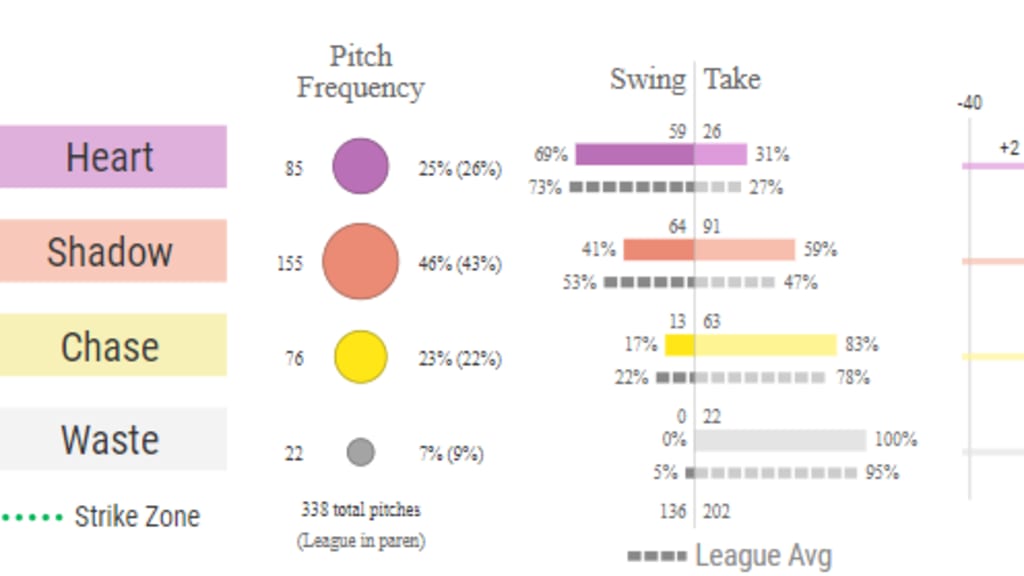Moments after Miguel Cabrera’s 3,000th career hit on April 23, there was a symbolic passing of the torch in Detroit. With Cabrera on base, Tigers rookie Spencer Torkelson launched a three-run home run to drive in his predecessor at first base, and the two embraced at home for the third homer of Torkelson’s young career.
But other than that emotional homer, it hasn’t really been the debut expected from the No. 1 overall pick in the 2020 Draft. He’s hitting .174 with a .615 OPS and 26 strikeouts in 22 games. Those numbers might be some cause for concern, but dig a little deeper, and the best of Torkelson’s rookie season may be yet to come.
Here’s how the 22-year-old phenom is impressing despite his low production, and how one adjustment might lead to the big breakout many are expecting.
Note: All stats are through Wednesday's games.
He's selective, especially for a rookie
Torkelson has swung at about 20% of pitches out of the zone thus far, giving him an excellent chase rate that ranks in the 88th percentile of MLB hitters. Only three rookies have lower chase rates this season: Cubs outfielder Seiya Suzuki, who had nine seasons in the Nippon Professional Baseball League before coming stateside, Rays infielder Taylor Walls and D-backs outfielder Cooper Hummel, both of whom have significantly fewer late appearances than Torkelson.
His elite plate discipline has been apparent since his days at Arizona State, where he broke the school record for most homers by a freshman that was previously held by Barry Bonds, while posting a .467 career OBP. In his lone season in the Minors, Torkelson had a .383 OBP, which was notable for his first time facing professional pitching.
His OBP in the Majors is .296 and his wOBA sits at just .288, but his xwOBA, which is based on exit velocity, launch angle and other factors, is .347, suggesting that Torkelson’s results have been a bit unlucky so far.
When he swings, he can do damage
Torkelson has also been great at punishing the ball this season. His 91.4 mph average exit velocity is higher than the likes of Anthony Rizzo and Corey Seager and is third-highest among rookies with at least 25 batted ball events, behind only Matt Vierling and Jeremy Peña. He’s been proficient at hitting fastballs especially, slugging .545 against the heater.
Hitting the ball hard is one thing. Hitting the ball hard in the air is another. When the ball finds Torkelson’s bat, he’s hitting line drives and fly balls. His average launch angle is over 17 degrees and he’s finding the sweet spot almost 40% of the time, a rate that would put him within the top 75 of more than 300 batters with 25 batted ball events.
Combine that with a hard-hit rate of nearly 45% – league average is 35.5% – and you get an impressive barrel rate of nearly 10%. In other words, when Torkelson is putting the bat on the ball, he is making the best sort of contact frequently.
He might be a small adjustment away
So, his plate discipline is amazing. He’s hitting the ball hard. What’s leading to his subpar results?
Torkelson’s main shortcoming so far is that he might be a little too selective at the plate. He’s swung at about 40% of pitches seen and 60% of pitches in the strike zone, both of which are more than six points below MLB average. While this isn’t necessarily a bad thing – Mike Trout has a similar swing profile – pitchers are throwing Torkelson 50.6% strikes, a few ticks more than the 48.5% MLB average and a bit more than an elite hitter like Trout, who is seeing just over 46%.
He’s not taking advantage of strikes in the heart of the zone either. Of over 170 hitters who have seen at least 25 strikes more than one baseball width inside the edge of the zone while ahead in the count, Torkelson has the sixth-lowest swing rate. When he does swing at pitches he can hit, he’s punishing them, hitting .304 and slugging .609, but when he swings at pitches one baseball width inside or outside the edge of the zone, known as the shadow zone, his numbers plummet to .156 BA and .250 SLG.
By taking so many pitches in the heart, he's opening the door to allow pitchers back in the count, where they will attack in the shadow zone, and leaving his best opportunities to do damage on the table. His swing/take value, where each pitch is assigned a value based on its outcome, sits at -1 for the year, but his swing/take value in the shadow zone alone is -7, while it sits at 0 in the heart and +3 in the chase zone.

This has led to 26 strikeouts in 22 games, and Torkelson has been caught looking on 10 of those occasions, which is tied for ninth-most in MLB. His 32.1% strikeout rate puts him in the 10th percentile of MLB hitters despite a chase rate in the 88th percentile.
As a rookie, he’s showing two incredibly important skills for a Major League hitter: patience and the ability to make hard contact. Torkelson has a great feel for the zone at the plate. He knows when not to swing, but actually getting the bat off his shoulder has been a problem, especially early in counts. If he can sacrifice a bit of patience for some early count swings, it will keep him from falling into two-strike counts and force pitchers to be a bit more selective, which would allow his elite discipline to really shine and lead to his numbers skyrocketing.
